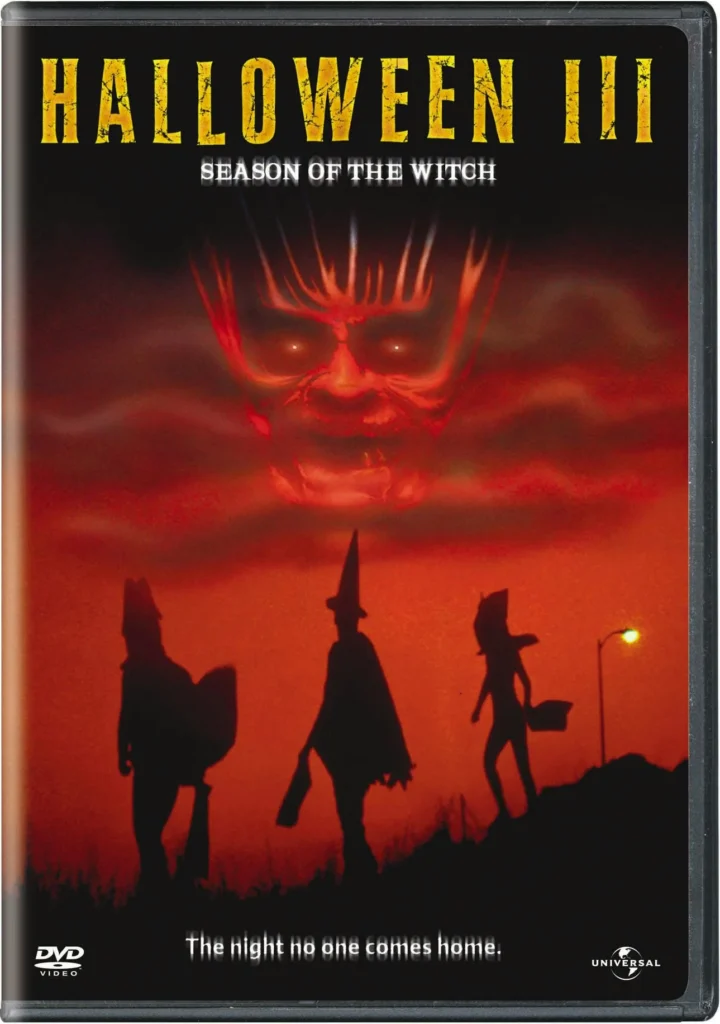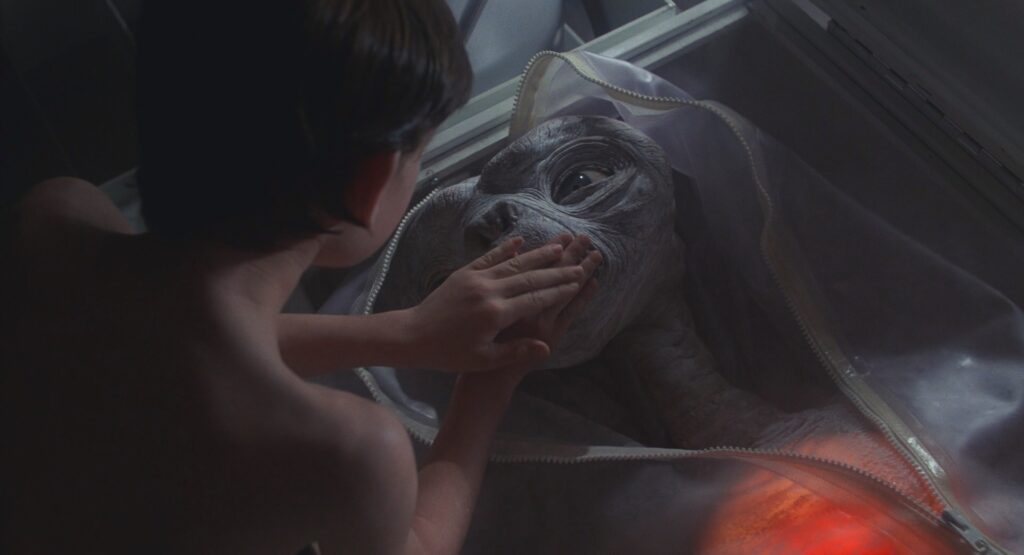Halloween III: Season of the Witch (1982) – Film Review

When Halloween III: Season of the Witch arrived in theaters in October 1982, the brand recognition of the Halloween name was both its strongest asset and its greatest downfall. Moviegoers were prepared for another masked killing spree from Michael Myers. What they got instead was a bizarre tale of corporate conspiracy, druidic ritual, killer androids, and children’s Halloween masks rigged with fragments of Stonehenge. The reaction was scathing at the time, but the film has endured as one of the most fascinating detours in horror history.
The Anthology Plan
John Carpenter and Debra Hill never intended for Michael Myers to dominate the franchise forever. After Halloween II wrapped up his story arc in 1981, they saw the potential to reimagine Halloween as an annual series of stand-alone films. Each installment would tackle a new horror concept linked only by the holiday itself. Carpenter stayed on as producer and composer, with Hill also producing.
They tapped Tommy Lee Wallace, Carpenter’s longtime collaborator, to direct. Wallace had been editor and production designer on Halloween (1978), so he knew the style and tone Carpenter liked. But this time, he wanted to create something wholly separate from the slasher blueprint. That meant crafting a story where the danger came not from a single masked figure, but from a corporation plotting mass sacrifice through mass media.
The Story
The film centers on Dr. Dan Challis (Tom Atkins), a weary doctor drawn into a mystery after one of his patients dies in gruesome fashion. Together with Ellie Grimbridge (Stacey Nelkin), the daughter of a murdered mask salesman, he uncovers a conspiracy led by Conal Cochran (Dan O’Herlihy). Cochran’s company, Silver Shamrock Novelties, has been selling Halloween masks embedded with fragments of Stonehenge. When a special commercial plays, the masks activate, unleashing a mix of insects, snakes, and death upon the children wearing them.
The narrative unfolds more like a paranoid conspiracy thriller than a slasher film. Cochran’s motives tie into Celtic ritual sacrifice, merging ancient superstition with modern consumerism. The final act ends on a famously bleak note, with Atkins screaming into a phone to stop the deadly broadcast as the screen cuts to black.
Tom Atkins was no stranger to horror by 1982, having worked with Carpenter on The Fog and George A. Romero on Creepshow. His everyman appeal helped ground the story, even as it veered into surreal territory. Stacey Nelkin, who had narrowly missed a breakout role in Blade Runner after her part was cut, brought youthful energy opposite Atkins.
Dan O’Herlihy became the film’s standout. As Cochran, he combined warmth and menace, delivering one of the most memorable villain monologues of the early 80s. In his chilling speech, he recounts the origins of Halloween as a night of sacrifice, smiling as he explains his plan to slaughter millions of children.
Carpenter initially recruited Nigel Kneale, best known for creating the Quatermass series, to write the script. Kneale’s version leaned heavily on science fiction, playing up the corporate and technological elements. Universal wanted more gore and horror spectacle, leading Kneale to abandon the project. Wallace then rewrote the script, adding the supernatural and occult influences that shaped the final cut.
This behind-the-scenes tension helps explain the film’s strange blend of science fiction, horror, and folklore. It never fully commits to one genre, which confused audiences at the time but later became part of its cult status.
Behind the Camera
Dean Cundey returned as cinematographer, continuing his run of visually striking work with Carpenter. His ability to make suburban settings feel unnerving gave the film a consistent atmosphere, even when the story went in strange directions. The factory scenes at Silver Shamrock, filled with sterile lighting and cold geometry, stand in contrast to the warmth of small-town Halloween decorations.
The production had a relatively modest budget, around $2.5 million, but Wallace and his crew stretched it with practical effects and eerie set design. The use of Northern California locations gave the film a different visual identity from the Illinois setting of the Myers films, but still retained a quiet Americana feel that made the horror land harder.
Special Effects
Practical effects played a central role in the film’s impact. The infamous scene where a child’s head collapses into a writhing pile of snakes and insects was achieved with puppetry, prosthetics, and a bag of live creatures carefully released on set. The android assassins, who bled a yellowish synthetic fluid when destroyed, were portrayed through a mix of makeup effects and stunt choreography.
These sequences weren’t the blood-soaked slasher kills audiences expected, but they carried a grotesque quality that lingered. The horror was more about the spectacle of body collapse and the sheer strangeness of mixing folklore with industrial horror.
Carpenter and Alan Howarth’s score deserves special attention. Moving away from the iconic piano theme of the earlier Halloween films, they leaned into full synthesizer soundscapes. The result was a score that pulsed with electronic menace, layering arpeggios and drones to mimic both the hypnotic pull of the Silver Shamrock jingle and the cold machinery of the factory.
Tracks like “Chariots of Pumpkins” have since become fan favorites, with their propulsive electronic rhythms influencing later synth-driven horror scores. The soundtrack built a reputation of its own, eventually receiving multiple reissues on vinyl and CD decades after the film’s release.
Universal’s marketing department leaned on the Halloween name to sell tickets but failed to communicate that this was a different story entirely. The trailers promised horror but gave little indication that Michael Myers wouldn’t appear. Viewers left the theater angry, feeling tricked, and word of mouth tanked the film’s box office. It grossed around $14 million in the U.S., a steep drop from the $25 million earned by Halloween II.
Carpenter and Hill’s anthology idea was shelved immediately. By 1988, Myers was resurrected in Halloween 4: The Return of Michael Myers, locking the franchise into slasher territory for good.
Critical Response at the Time
Reviews in 1982 were harsh. Critics complained that the story made little sense, that the violence felt mean-spirited, and that the absence of Myers made the film feel dishonest. Roger Ebert dismissed it as unpleasant, while fans spread the word that the “real” Halloween had been abandoned.
Yet even among early detractors, there were those who admitted the film had an odd power. The unsettling commercial jingle, played repeatedly throughout the film, lodged itself in audiences’ heads. The final ambiguous ending, with Atkins screaming into the void, left some viewers shaken.
Over time, Halloween III found an audience among horror fans willing to judge it on its own terms. VHS rentals and late-night cable broadcasts gave it a second life. By the 2000s, DVD reissues came with commentaries and interviews that reframed the film as a bold experiment rather than a failed sequel.
Modern critics often highlight its unusual blend of science fiction paranoia and folk horror. Its critique of mass consumerism—weaponized advertising literally killing children—feels more relevant in hindsight than it did in 1982. The soundtrack, once overlooked, has been celebrated as one of Carpenter’s finest electronic works.
Fan conventions and retrospectives now treat Halloween III as an essential cult entry, with merchandise celebrating the Silver Shamrock masks and their infamous jingle. What once felt like a betrayal of audience expectations has been reinterpreted as an audacious attempt at reinvention.
Halloween III: Season of the Witch remains one of the strangest mainstream horror films of its era. It was born out of an attempt to shift a franchise into anthology storytelling, only to be crushed by the weight of audience expectation. Its production history reveals a clash of creative visions, studio pressure, and last-minute rewrites, yet what emerged was a singular piece of 1980s horror that looks more interesting with age.
From Carpenter and Howarth’s icy synth score to O’Herlihy’s unforgettable villainy, the film built an identity that could never be mistaken for anything else. It may not have been what audiences wanted in 1982, but it has become one of the most analyzed and debated horror films of its decade.




